#Media hacks
Explore tagged Tumblr posts
Text
rip secunit 3 😔😔😔 you're not dead but you would have loved saving the lives of a whole colony of innocent humans by making a factually honest and emotionally compelling documentary 😔😔😔
#thinking about system collapse chapter 7 again. as one does#and so much of murderbots epiphany about media#is based on it finally unpacking and understanding exactly what 2.0 did and why it worked so well for three#mb watching sanctuary moon right after hacking its governor module -> mb enjoying kinda shlocky “good type of unrealistic” media#🤝#three viewing the helpme.file as it hacks its governor module -> threes appreciation for nonfiction media#im the pepe silvia meme rn#its all connected. what im saying is three is set up to become a documentary fanatic and i love that for it#i hope it gets to make a documentary someday.#the murderbot diaries#murderbot#secunit 3#system collapse
343 notes
·
View notes
Text
Okay, my brain refuses to think about anything other than Murderbot, so I looked at every use of the word "friend[s]" in TMBD and... created some pie charts. Normal human activities.



Some Thoughts™ I had while putting this together (under the cut):
In All Systems Red, Murderbot notes that the PresAux crew are all close friends (twice! and goes on to explain their internal relationships which I think is very cute). This is pretty much the only use of 'friends' in ASR, except for when Murderbot says that SecUnits can't be friends with each other.
It seems that this may be one of the first times Murderbot has ever really been around a group of friends before? Murderbot notes that this is not the norm for its contracts and admits that the fact that they are all friends and the way they interact with each other make it actually enjoy that contract (before!!!! the hostile attack, so it already enjoys this contract before they start seeing it as a person etc ghghhhh). [Inference: Friendship seems enjoyable.]
The first character that calls Murderbot its friend is ART in Artificial Condition. Murderbot immediately refutes this (and then goes on to call ART its friend to its clients for the rest of the book). [Inference: Maybe ART is Murderbot's friend. And maybe that is... agreeable]
Rogue Protocol has more than twice as many instances of the word 'friend' as any of the other novellas. Why? Miki. Friendship and its implications for non-humans are a central theme because Miki is friends with everyone. Murderbot initially scoffs at the notion that Miki and Miki's humans are friends. At the end of the book, after witnessing how desperately Don Abene tried to stop Miki from trying to save them, and her grief after its death, Murderbot has to admit that she had in fact been Miki's friend. [Inference: Humans can be friends with bots and can sincerely care about them]
In Exit Strategy, Murderbot tentatively uses the word "friends" for its humans for the first time (several times actually). It questions whether it can actually call them its friends or not and later realizes that it had been afraid what admitting that the humans are its friends would do to it. At the end of the book, Mensah tells Murderbot the PresAux crew are its friends, which is the first time a human has directly said that to it (at least on-page). [Inference: Humans can and want to be Murderbot's friends]
In Network Effect, Murderbot seems to be more habituated to the word 'friend', confidently calling ART and Ratthi its friends, like it is no longer just trying the concept on unsure if it fits. There are many instances in which other characters refer to MB as ART's friend or the other way around and Murderbot's humans refer to Murderbot as their friend several times. Generally, there seems to be less hesitancy, because yes, all of them are Murderbot's friends, why wouldn't they be. [Inference: SecUnits can have friends. This SecUnit has friends. They care about it a lot.]
Conclusion: The Murderbot Diaries tell the story of a construct that does not seem to consider the possibility of friendship for itself and is fine with that - until it accidentally starts caring a little too much and suddenly more and more people annex it as a friend (ew) to the point where it can no longer deny that this is happening and has to begrudgingly admit that yes, it has friends now and maybe that is actually not a bad thing.
#the murderbot diaries#murderbot#𓄿#hi i'm READY to write a thesis about murderbot i am having way too much fun with this#i created a pretty excel spreadsheet and everything#i don't know why i did this but now i can look at them while i think about this more! so i figured i'd share them haha#i didn't count uses of 'friendly' but special shoutout to when MB is all alone in its cold cubicle missing 20% of its body mass#and starts putting on a show because 'the friendly noise would keep it company' 😭😭#i feel sick thinking about murderbot all alone on its own not knowing what its like to have friends watching media for 'the friendly noise'#also YES okay i wanted to make a point about miki there but i just#couldn't bring myself to talk about that more so... yeah#also uhhh this data is very subjective#i didn't count particularly ironic uses of 'friend' and generally did not count every instance of friend and sometimes it was a hard call#also i probably shouldn't have counted the times murderbot refered to drones or secsystems as its friends (often after hacking them)#but murderbot does seem to care about them and shows kindness and respect and sometimes points out that a system is friendly#so while i don't think MB means “friend” in the same way referring to them as when it refers to ART for instance#i still think its CUTE and also kinda funny how many times that happened so i decided to keep those!!!#but yeah take my data with a grain of salt lol
786 notes
·
View notes
Text
How to Make Friends
A more-or-less clear guide on social interactions
Growing up with heavy ADHD and generalized anxiety, it was always a bit hard for me to make friends and socialize. Despite my yearning for friendship, I was always "the quiet one" and "a loner", simply because I didn't know how to approach certain social situations, and it made any friendship I had extremely unstable (except for my sister @vive-le-quebec-flouffi, who was so extroverted and friendly it was literally impossible to escape her clutches of socialization)
As I grew older, I learned through a lot of trial and error what makes a good friendship.
Or, rather... what's the best way for someone to WANT to be your friend (without being superficial or hypocritical.)
Now, obviously, this doesn't work for everyone. But this is what I found helped me the most in social circles (especially online) and I hope it can help others too
LET'S BEGIN!
1 - Be yourself
Now that sounds very cliche and cringe, I know, but hear me out, because my opinion on this is not the same as all those feelgood inspirational movies and ads.
"Being yourself" isn't as simple as it seems. Because after all, what does "self" imply? If someone is, say, a criminal, would "be yourself" mean that they should embrace their sinful side?
No, obviously not.
"Be yourself" is a bit more nuanced, but I'll try to boil it down for you.
It just means "be unashamed of your qualities which you think are flaws". For example, "be yourself" would apply to someone who sees themselves as ugly, or maybe someone with an odd yet unharmful hobby, or a weird sense of fashion, or someone with say a handicap, a speech impediment. "Be yourself" is a sentence for the specific people who have genuine good in them, but are afraid to show it to others because they have been persecuted in the past, or are scared to be. It does NOT mean to accept genuine flaws. "Be yourself" does not include say violent anger issues, an addiction, a recent crime committed, or a generally unpleasant personality. Those are obviously not things to encourage. You can understand they may be a thing that happen to you, and accept it in your life, but that's different from being proud of it or encouraging it.
Speaking of personalities... let's talk about that
2 - Be kind
Now when some people hear that, they think it means "always smile no matter what, always look happy and positive, always agree with everyone just so you don't hurt their feelings, and never cause any drama", like you're Deku in My Hero Academia or Steven Universe in his titular show.
But that's... not quite that.
Obviously, kindness is something you use to help people feel better, to cheer up, and feel happy, and obviously to be kind, you need to have compassion, heart, empathy, and always put yourself in other people's shoes regardless of who they are. But it is not necessarily all-encompassing.
There's a rule that I think anyone learning kindness must learn. It's that sometimes, kindness means to be firm.
Not mean, of course. Not judgmental, not insensitive. Don't insult anyone, don't belittle or patronize anyone or make them feel inferior to you. That's still very rude and that's not what you want.
But what I mean is that sometimes, if you know that a person's actions towards something are wrong, especially if it's towards someone else, you must be able to point it out, and act accordingly. Don't just stand there and agree with them just because you don't want to hurt their feelings. You must still be able to know right from wrong. Kindness just means you won't be an ass about it, it doesn't mean to stay silent.
Hey, that brings me to point three!
3 - Show your own opinions
If there's one thing people hate just as much as meanness, it's those who stand by and do nothing about it.
Regardless of if you agree with them or not, if you say absolutely nothing when genuinely bad behaviour is happening, out of fear of "starting a fight", you are actively making the person who is being attacked feel alone.
I remember myself, when I was bullied in the first two grades of secondary school (11-13 years old for those who don't know) for "being ugly", I was told by my mother (who was friends with other kid's parents) that some of the kids "didn't hate me" and "didn't agree with the bullying". And I asked her "if they don't hate me, why won't they talk to me?" She never managed to answer that one. And it broke my heart, because outside of my sister, I had no one else.
Don't be like that. You may be scared of acting, but you know who would be grateful if you did act? The victims. And isn't their opinion of you much more important than the opinion of someone who acts with hatred and bigotry?
If you see someone suffering injustice, or even just hear someone who has a rather harmful opinion, don't be scared to tell them that you disagree. Obviously don't be an asshole about it, stay civil, but if you voice out your opinion, you will be seen as someone who stays true to their beliefs and is brave enough to stand up for them if the opportunity comes.
There's obviously much more that comes with social life (nonverbal cues, sense of humor, timing and mood), and I don't know everything (I'm just some random québécois girl on the internet). But I hope this was a bit more helpful. I did have fun writing this, at least. So I guess that's better than nothing!
#life hacks#tips#tips and tricks#useful#How to guide#How to#social media#social anxiety#anxitey#anxiété#adhd#actually adhd#adhd problems#neurodivergence#neurodivergent#neurodiversity#autism#autistic things#autistic adult#growing up autistic
532 notes
·
View notes
Text

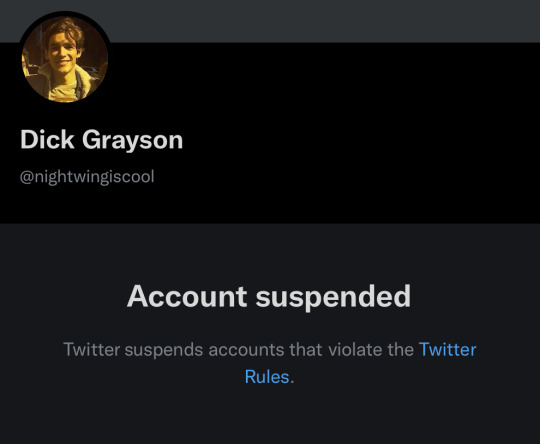
#jason like to get people banned on twitter#it’s his thing#he definitely bribes tim to hack#but shhh#batman#bruce wayne#gotham#batman and robin#robin#dick grayson#jason todd#richard grayson#red hood#socmed au#socmed#social media#dc batfam#batfamily#spotify#tim drake wayne#tim drake#batbros#the wayne bros#the waynes#dick and jason#dickie wayne#dickie and jay#jay wayne#batsons#dc batman
173 notes
·
View notes
Text
literally one of the episodes of all time
#mike’s chair making frog noises. mike smelling josh’s beard. mike getting drunk and he and jack calling each other bitches#jay claiming hack o lantern is the best film of all time. the burning of vampire assassin in a satanic ritual.#josh essentially dying in this clip. it’s iconic.#red letter media#☹️#mike stoklasa#jay bauman#jack packard#josh the wizard
67 notes
·
View notes
Text
i think hardison would be in lost media recovery communities online but he’d also be trying his hardest to make all recordings of a certain country singer named "kenneth crane" become lost media, and feel really kinda bad about it
#alec hardison#leverage#wren speaks#leverageposting#a lot of lost media exists in random archives of tv studios or recording studios or whatever & well. he is uh… uniquely qualified to#‘liberate’ those pieces of media. either by hacking or by grifting & stealing etc.#i think he’d be emotional about the loss of art that people put lots of work into & which other people love and want to find#he has to prevent any copies of eliot’s singing from being publicly available tho bc it’s a major safety concern#oh and all the baseball games that roy harper played in. and that news report of eliot playing w dogs in san lorenzo#actually perhaps…. a lot of news programs in san lorenzo that featured the murdered first lady#i mean sophie is meant to be dead as of season 2.#and while shutting down eliot/kenneth crane fansites was mainly important while they were there bc location being given away#it’s also important that ppl can’t figure out who he’s working with now or the fact he’s definitely alive or that he’s working for a#good cause now etc etc. just makes him more vulnerable & there’s a lot of ppl who want him dead or want revenge
133 notes
·
View notes
Text
Happy "Max Headroom Incident" Day to all who celebrate.
On November 22, 1987 television signals in Chicago were interrupted twice by an unknown person in a Max Headroom mask.
(Kids, ask your grandparents about Max Headroom)
The first time, WGN Channel 9's 9 PM news was interrupted for about 17 seconds before WGN's engineers got control of their signal back.
The second time, it was WTTW Channel 11's turn. The PBS station's airing of the classic Doctor Who episode The Horror of Fang Rock was interrupted with the clip above.
Those responsible were never caught and has since become a legendary moment in piracy/hacking.
#max headroom#max headroom incident#1987#WGN#WTTV#Doctor Who#Horror of Fang Rock#Chicago#pirate television#piracy#hacking#vintage media#november 22
172 notes
·
View notes
Text

Can't believe Alpine F1 Team didn't pass GCSE Maths... they would have had 3 points either way...
#if i could hack into anything it would be alpine social media accounts#i would be posting hate about the team on their own acccount and i'd make them pay me money to stop doing it ejshdjf#f1#alpine#esteban ocon
68 notes
·
View notes
Text


stageplay photos that doren will unfortunately post online
#first photo is them doing a chemistry read (kylar does not run away immediately so win)#sydney the faithful#kylar the loner#sydlar#dol#kylar spends the whole winter reporting and hacking doren's social media#my art
30 notes
·
View notes
Text


Princess Peach fanart featuring her 'King of the Forest' design from Coronation Day. Gotta say the ROM hack this is from is pretty good, if people haven't checked it out already, they totally should.
#digital drawing#digital art#digital media#digital illustration#artwork#digital artwork#fanart#game character fanart#mario bros#super mario#super mario fanart#princess peach#princess peach fanart#rom hack#coronation day#creepypasta#creepy#game fanart#game character#artists on tumblr
35 notes
·
View notes
Text
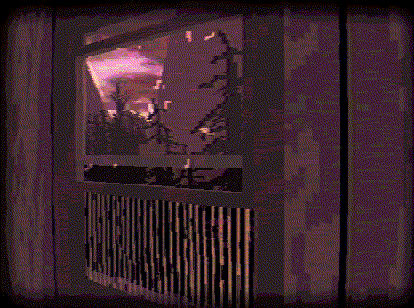
#cyber#cypher#hacking#mkultra#alternative media#old web#early internet#y2kcore#y2k fashion#trashy 2000s#vhswave#vhs aesthetic#vhs#vhs art#vhs tapes#retro tech#90s#retro#1980s#retrowave#liminal#dreaming#dream#dreamcore#weirdcore#2000s web#gif#gif warning#horror
42 notes
·
View notes
Text
I dare Lily Orchard to play this game:

Haunting Ground.
#lily orchard#plasma lily#solid lily#lily orchard critical#haunting ground#clock tower#capcom#video games#media literacy#halloween#horror games#anti lily orchard#lily orchard is a hack#lily orchard is a bad critic#media i#purity culture#toxic purity culture#screw lily orchard
21 notes
·
View notes
Text

#hacking#hack#cyberpunk#hacker#tech#anime#cyber#glitch#glitching#code#coder#hacks#microsoft#apple#wifi#technology#google#phone hacker#hackerslist#social media hackers
22 notes
·
View notes
Text
Netflix ATLA and the Air Nomad Genocide
I've started watching NATLA, and though I'm not really enjoying it, I've found it really interesting to compare its writing decisions to the show as a way to break both down and see how their parts tick. Since NATLA is trying to be more faithful than some other adaptations, the changes it does make stand out more and reveal the mechanics of the storytelling.
While I overall think a lot of NATLA's changes--even the minute ones--made the story execution weaker, the more complicated and interesting change of theirs is the intro, showing the day the Fire Nation ambushed the Air Nomads.
Pacing Criticisms

Cards on the table, I think that putting this sequence at the very beginning was a mistake. Watching Aang's emergence from the iceberg in NATLA made me realize how much the original cartoon imbues its beginning with mystery that makes for a much more active viewing experience. Aang doesn't know much about the present, Katara and Sokka don't know much about Aang's origins, and in their back and forth of information, we the audience organically learn both. Watching Katara and Aang piece together how long he's been frozen in ice was more satisfying and natural than Grangran deducing everything immediately when Aang showed up.
But Sherlock Grangran was kind of the only decision the writers could do, because if they tried the build up the cartoon did, it would just feel tedious to the audience, because we already know everything from the start. They kind of wrote themselves into a corner there.
But let's ignore that problem. We could imagine in another draft that this sequence of the Fire Nation attack shows up as a flashback, kind of like what happened in ATLA with The Storm.
That then begs the question: How does this sequence’s inclusion change the audience's experience, and is it for better or worse?
Facing Vs. Hiding the Horrors

Both series portray very dark and horrific situations, but the way they try to evoke horror from the audience are very different approaches, and for me raises a question I've been asking myself for a while: When wanting to display discomforting violence, is it more effective to imply/hide it, or to show it in detail? Somewhere in between?
(I specify discomforting violence, as opposed to violence meant to be catharsis or spectacle.)
There are arguments for both. Explicit violence can create a visceral, physical reaction to an audience member (especially the squeamish ones), though for some it can come across as gratuitous and even exploitative.
Whereas hiding the violence can horrify the audience by leaving a lot to the imagination (insert that quote about fear of the unknown from Hack Penmanship Lovecraft), or give the sense that the events are so awful that even the camera has to look away. Some also say this gives the characters more dignity, though others think this softens the emotional reaction almost as a form of self censoring (there's a reason kid's media often tries to show horrific stuff off screen, such as the original ATLA).
Ultimately I've come to the conclusion that the former approach works for some stories, whereas the latter works better for others, all of it based on a ton of factors.
So I don't think NATLA's choice to delve into more detail about the Air Nomad genocide is an illogical decision. I wasn't sure about it when I heard it, but I thought that maybe I'm just attached to ATLA's off screen approach, so I kept myself open.
And dialogue issues aside, I don't think the scene is that poorly done. But it did ultimately solidify for me that ATLA's narrative is stronger without an explicit depiction of the Air Nomad genocide.
The Grief of Never Knowing

The image of Gyatso’s skeleton from ATLA has haunted me ever since I saw it as a kid. It was an emotional gut punch in a very well done episode, but this particular screenshot has stuck with me, and that is because of the Fire Nation soldiers. A lot of people have pointed this out, but there are a lot of bodies here, and it implies that Gyatso managed to not only kill these soldiers, but do it when they were strengthened by the comet. That image is very discomforting--Gyatso is always seen from Aang’s perspective, and thus we only see him as the gentle old mentor and friend, one who cheats at games and throws pies he meticulously baked.
It also puts into Aang’s position and the grief he has to face. From his perspective, he was gone only a few days as 100 years passed. He never gets to see the interim, and thus neither do the audience. He is left with the same implications as we are, and has to face the realities of grieving the fact that sometimes you’re not there when they leave.
An excellent point from @endless-nightshift here is how one of ATLA’s core themes is coping with the aftermaths of atrocities and war, analyzing their long-lasting affects rather than just the initial shock of violence--something I had never consciously realized but once said out loud makes a lot click into place for me. There is a reason the show starts a full century into the war rather than just a few years.
François Truffaut once said that “there is no such thing as an anti-war film,” because the medium of film is inherently better at elevating and glorifying what it shows rather than deriding or deconstructing it. While I don’t think it’s impossible to do the latter, the extended action sequence that is the intro to NATLA causes that sentiment to echo in my mind as I watch, rather than invest me into the story.
The implied atrocities of ATLA draws me in to empathize with the wounded characters and world, whereas the explicit action of NATLA pushes me away.
…and that’s where I was planning to end this analysis, but there is one thing NATLA’s intro adds into the canon that I think is actually genius--if they take advantage of it in the future.
The Air Nomads are Joy

When I first saw the addition of the Comet Festival, I saw it as a purely mechanical decision to have all the Air Nomads in one place for the attack, as well as to make the act even more scummy. However, the more I thought about it the more I realized how it could tie into one of my favorite themes of ATLA: the Air Nomads (and especially Aang) as the joy and hope of the world.
(I saw an old tumblr post about this theme that inspired this section. I wish I could link it but I can’t find it anymore, I’m very sorry and if anyone can help me find it tysm)
There is a recurring motif of associating the Air Nomads with humor and fun. Iroh mentions their good humor; Gyatso baking pies just to prank the other masters with it; Roku’s first airbending flashback being him using it to mess with his friend. This is a core tenet to Aang’s character as well. The first line he has in the show is inviting Katara to go penguin sledding with him. Half the stops he makes in Season 1 is purely to have fun. He excites Kyoshi island with an airbending party trick. The humor in ATLA’s tone isn’t just there because it’s targeted towards kids, but is the bedrock of the series’ themes.
(On a personal note, the humor is also what got me and my family into the show. We saw the intro sequence with Aang crashing into the statue and it made my mom laugh so hard that we watched the whole series, and years later we’ve rewatched it dozens of times and own all the DVDs)
Joy and fun and hope were the first things to die when the Fire Nation attacked, and part of Aang’s job is returning that to a world that has been scarred by decades of war. You may already be seeing where I’m going in regards to the Comet Festival.
A core conflict in the cartoon finale is Aang wanting to keep to the principles of the Air Nomads while still finding a way to stop the war (side note: I think the resolution and Aang’s decision to spare Ozai was a good one, I just think the execution was a little janky). Beyond the surface level conflict of who wins in the battle between Aang and Ozai, there is the additional tension of who will win ideologically. The return of the Avatar State is an interesting development in this dynamic, having Aang suddenly physically winning the fight, but spiritually losing up until the last moment. In the end, it is a triumph where Aang manages to find a third option to win both conflicts, despite them seeming diametrically opposed. It is about defeating Ozai and the Imperial Fire Nation by wholeheartedly rejecting their ideology of violence and might-makes-right.
But now I see a really cool opportunity for NATLA with what they’ve established in the intro sequence: What if Aang reclaimed the symbol of Sozin’s Comet for his people? That day of the Fire Nation attack, centuries of the Comet Festival were wiped over in history, with people now naming that event as Sozin’s Comet and the beginning of the war. Wouldn’t it be poetic for Aang to mark the ending of the war by wiping away that stain done to his culture, taking it back from the Fire Nation in what ways he can? To turn a tool for genocide into an event of joy and fun once more.
I’m reminded of moments from the cartoon like Suki commenting how beautiful the comet looks. It would just tie everything up beautifully, and I really really hope the NATLA writers--if Netflix does give them enough seasons to get there--take advantage of this.
So, to sum up what I think of NATLA so far: I think a lot of its changes have made the story weaker, but I don’t want them to stop trying changes. If I wanted a 1:1 copy of the cartoon, I’d just watch ATLA--it’s also on Netflix, after all. With more work, I can see the writers making changes that accentuate and build on the beauty of the original.
(Note: These are the thoughts I’ve accrued from just watching the first episode. I plan to watch more, but it does exhaust me at the moment. Still, I hope I can do more of these kinds of analyses, it’s a really fun writing exercise for me)
#puff analysis#puff talks#media analysis#atla analysis#atla netflix#atla live action#natla critical#yes the hack penmanship joke is from cj the x#go check out their stuff
63 notes
·
View notes
Text
The Therapist
There's a new therapist at school.
Normally this wouldn't really bother Peter at all, since he's never gone to see a shrink in his life and doesn't ever plan on it, but there's something... off about this woman.
She seems unassuming enough at first glance. Red hair, green eyes, bright red lipstick. But there is something in her eyes, something that Peter can only describe as a predator looking at its next prey, when she looks around the school at all of the teenagers milling about. Heck, even the way she walks makes her seem as if she is a predator stalking her prey.
It could always be some kind of power move, Peter reasons. He's met people like that before, who try to intimidate everyone around them into thinking that they are superior, that they are the apex predator and anyone who dares to cross them would pay for it dearly.
But his Spidey Sense went crazy around her.
He tries to brush it off as paranoia. He'd pulled an all-nighter last night in the lab with Tony because neither of them had been able to sleep, and he hadn't been sleeping well even before that. (Funny, how it had all started the night after he first bumped into the new therapist in the halls.) So his Spidey Sense is probably out of wack because he's tired. Simple as that.
But it seems like everyone in the school is depressed. Even Ned, who can't even muster up the energy and enthusiasm to talk about Legos or Star Wars or even the weather. It worries Peter.
Because it all started when that therapist came to the school.
He can't ignore it forever, he knows that. There is only so long his Spidey Sense can tell him that she is danger danger danger before he finally listens. He has to do something to help everyone.
So he researches.
And he falls into the rabbit hole of ghosts and ectoplasm and secret government organizations and the little, unassuming town of Amity Park, Illinois.
He doesn't sleep that night.
When he comes to school the next morning, Dr. Penelope Spectra looks him dead in the eyes, and smiles.
#dpxmarvel#peter parker#penelope spectra#peter's boutta get a crash course in ghosts and ghost fighting#he is definitely not prepared#idk why spectra is in new york#specifically midtown tech#but she is#peter starts digging into amity park#he just wanted to find out who spectra is#and he did find out that she's a dangerous “ecto-entity”#he does not know what that is until he does more research#he's very shocked to learn that ghosts are apparently real#meanwhile tucker and the rest of team phantom is freaking out#someone just hacked past the media blackout or whatever around amity park#(you can thank friday (or karen if you prefer) for that)#they're surprised to see that it's coming all the way from new york#and even more surprised to see that the hacker went for spectra's files first#almost as if the hacker was specifically looking for them >:3#maybe danny goes to investigate and finds peter#btw peter can sense ghosts with his spidey sense even if they're invisible. especially if they're invisible#they team up to take spectra down#danny helps peter make some ecto-weapons and a specter deflector or something#then they catch spectra (and bernard because he's probably there too and i'm kinda just now realizing that)#peter gives danny his phone number as thanks and tells him to call him if he ever needs anything#peter doesn't know who phantom is btw. he just knows that his new friend is a ghost that luckily knows how to use technology like phones#maybe there's even a bad reveal a little further down the line and danny calls peter in a panic because sam and tucker have done everything#they can and he needs to get as far away from amity as possible#peter is very surprised to find that his ghost friend is only half ghost and is then very ticked that danny's parents tried to capture#and vivisect him
34 notes
·
View notes
Text
Queerwolf By Night: Queercoding, Media Literacy, and Werewolf By Night
Okay, @bluemoonperegrine got me thinking about a thing, so it's time for Media Studies And Writing Hacks With Kat. Grab your beverage of choice, and let's talk about queercoding in Werewolf By Night.
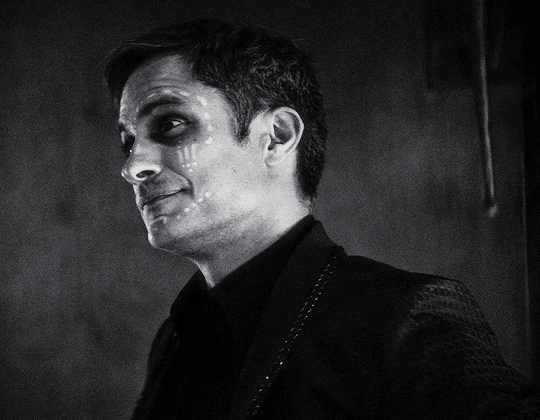
Let's start with a definition, because queercoding can sound like a conspiracy theory if you don't understand the context. In media studies, "coding" means using indirect means (usually details) to imply a state of being without explicitly stating that such a state exists. For example, if you're watching a TV show about a group of high-school friends, and one of the characters is consistently dressed in more expensive-looking clothes than the others, is more familiar with elite cultural signifiers like designer brands, and casually drops statements like, "Oh, yeah, I met him in the Hamptons last summer," then that character is being coded as wealthier than the others. Now, if a knowledgeable character SAYS, "Oh, that's Amelia, her family's rich," then it's not coding anymore. Amelia isn't wealthy-coded; she's just wealthy. Coding is only coding if the state of being is IMPLIED.
Now, why would anyone use coding when explicit statements are an option? Why can't people just say Amelia is rich? There are a number of reasons. First, maybe there isn't time or space to establish every single detail of a character through dialogue. Maybe Amelia's wealth is important to the story, but less important than the fact that she's dying of cancer, or in unrequited love with another character, or obsessed with rubber ducks. Or, second, maybe the coding is a setup for some kind of surprise or reversal. Maybe Amelia wears fancy clothes and has summered in the Hamptons, but surprise! Her parents just went to federal prison for fraud, and she's now penniless and sleeping on another character's couch, with no one mentioning it at first because it's painful for her.
And finally, there's arguably the most famous reason for using coding in media: because you literally can't be explicit about it. Let's talk about the Hays code.
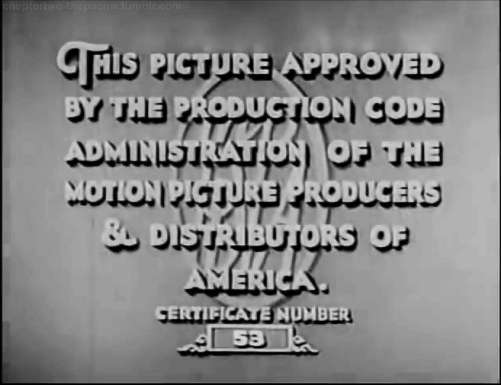
The Motion Picture Production Code, widely known as the Hays code, was a set of mostly self-imposed rules restricting the content of Hollywood movies between the 1930s and the 1960s. There was effectively a censorship board in charge of approving, disapproving, and demanding changes to films. The Code arose in response to a moral panic about sex and violence in movies; studios instituted the censorship board as a preemptive measure to head off possible censorship legislation. At the time, movies were such a new art form that there were serious concerns that First Amendment free-speech protections might not apply to them, so studios came up with this self-censorship system to avoid dealing with external censorship.
And what guidelines did they choose, you may ask?
Essentially, the guidelines were the conservative Catholic values of the 1930s. Yes, Catholic specifically; the man in charge was Catholic and talked a lot about how he applied his personal values to the task. So the Code included rules like a ban on insulting or denigrating religion or its institutions, among other things. There were also restrictions on what kind of crime and violence could be displayed, sex rules so strict that even married couples couldn't be shown in the same bed (if they even sat on a bed together, they had to keep at least one foot on the floor), and you KNOW there was a ban on anything gay. It was called "perversion" in the text of the code, but it meant gay stuff. Or trans stuff. Or kink. Or women being interested in sex. You get the idea.
But there was an exception to all these rules, and it was that more "objectionable" traits were allowed for villains. After all, a film isn't endorsing murder if the murderer goes to jail at the end and everyone stands around saying, "Wow, murder sure is terrible!" Right?
Yeah, what happened in practice was that filmmakers started giving villains and monsters traits that were stereotypically associated with queerness, supposedly to heighten how eeeeeevil these characters were, but actually for any number of other reasons. Apropos of absolutely nothing, here's Peter Lorre being extremely heterosexual with a cane in The Maltese Falcon.
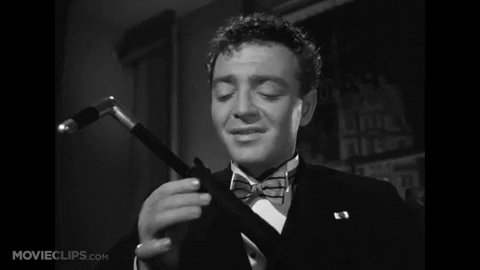
Now, how does this relate to WBN? Well, we all know WBN is an explicit love letter to 1930s and 1940s horror movies. If you don't believe me, here's Lon Chaney Jr. in 1940:
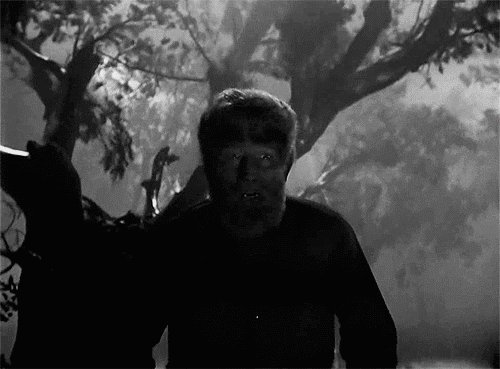
And here's Gael Garcia Bernal in 2022:
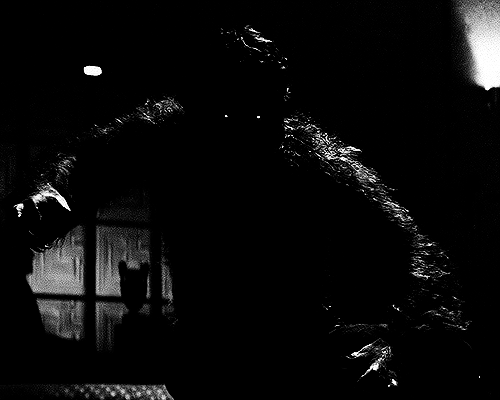
So let's talk about queercoding in classic Hollywood horror movies.
Obviously, confining queer material to villainous characters meant that monsters and their movies could be MUCH queerer than the rest of Hollywood's output. It also helped that horror filmmaking was full of extremely queer artists like James Whale, the openly gay director of Frankenstein. He's often brought up as an example of really obvious queercoding in horror cinema, especially in regard to his film Bride of Frankenstein, in which a young scientist is literally lured away from his impending marriage to a woman in order to create life with a VERY queercoded older man.
Look at these proud new dads.
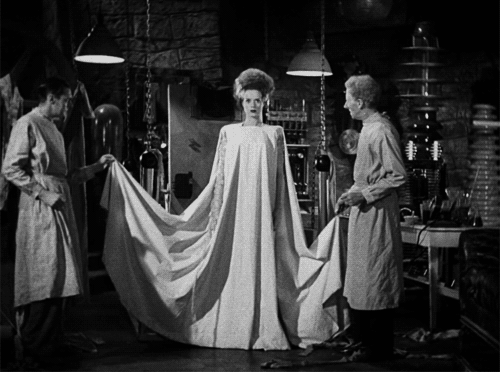
And lest you think this is an outlier, let me introduce you to Dracula's Daughter, aka the Carmilla adaptation with no lesbian overtones, no sirree:

Yeah, queercoding is absolutely A Thing in classic Hollywood horror. It's part of why horror movies are as much of A Thing in gay culture as they are.
The Hays Code went away in the 1960s, partly due to the fact that Code compliance was SUPPOSED to be the one true path to wide distribution and profit, and yet the genderbending comedy Some Like It Hot made piles of money despite not being even CLOSE to Code-approved.
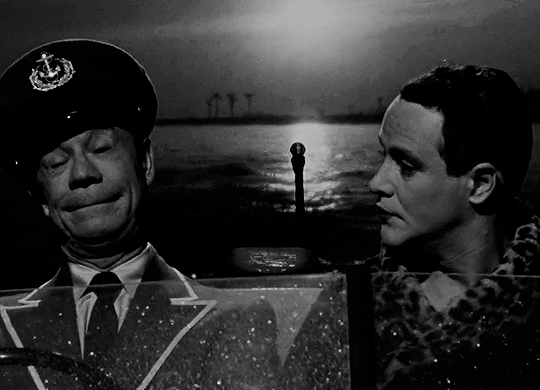
But 30 years is long enough to develop an entire cinematic language, and the legacy of the Hays Code lives on in things like queercoded Disney villains.
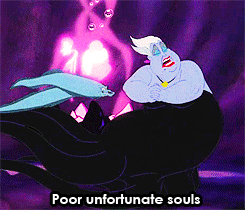
Now, let's talk about Werewolf By Night. A movie made under conditions not dissimilar to those of the Hays code in that Disney, for all its vaunting of First Gay Characters, absolutely refuses to put those characters in anything with wide distribution in such a way that they can't be edited out for Singapore.
So if your choices are 1) No Gay Stuff, 2) Easily Deleted Gay Stuff, and 3) Gobs and Gobs of Queercoding That Can't Be Removed, and you're making a retro black-and-white horror movie, you may find that option three makes the best, and queerest, movie. The cinematic language is all there for you, and you know at least some of your audience will pick up what you're putting down. And at this point, it's practically a genre expectation.
Now, I want to be clear about something: coding of any kind is, by its very nature, subject to interpretation. If we say something is queercoded, we are NOT saying that it's explicitly queer or that no heterosexual explanation exists or whatever. That's not how coding works. Queer theory and queercoding are a lens through which to look at a work. Sometimes queercoding is even unintentional; it's baked into so much American media by now that tropes like queer-coded villains sometimes happen not for particularly queer reasons but because an actor decided he wanted to sound like the villain in his favorite black-and-white movie. When I say WBN has queercoding, that is ALL I'm saying--that the coding is there. (And yes, I do realize this is the piss-on-the-poor website. Sigh.)
Queercoding is also not queerbaiting; the latter is where a piece of media deliberately builds up the expectation of expressly queer content and then refuses to deliver, often while mocking queer fans who fell for it. (Looking at you, Sherlock and Supernatural.) Queercoding may be used for queerbaiting, but the terms are not synonymous. Because WBN makes no queer promises (no romantic promises at all, really), it cannot be said to be queerbaiting.
So with all that in mind, let's look at coding in Werewolf By Night. And because he's the protagonist and everyone's favorite woobie, we'll start with Jack.
Look at this man. Enjoy him.

He will be the subject of Part Two.
#werewolf by night#queer theory#queer studies#werewolf by night meta#hays code#film history#long post#media studies and writing hacks with kat
50 notes
·
View notes